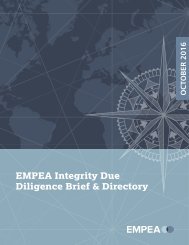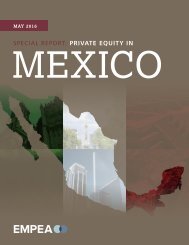Create successful ePaper yourself
Turn your PDF publications into a flip-book with our unique Google optimized e-Paper software.
The ‘stable’ centres in the bottom left <strong>of</strong> the chart (including the top four centres) have a relatively low sensitivity to changes<br />
in the instrumental factors and a low variance <strong>of</strong> assessments. These centres are likely to exhibit the lowest volatility in<br />
future GFCI ratings. Looking back at recent GFCI ratings, the stable centres are fairly consistently towards the top <strong>of</strong> the<br />
GFCI ratings.<br />
The ‘dynamic’ centres in the central band including four from the peer group (Dubai, Casablanca, Istanbul and Johannesburg)<br />
are the most interesting. They have a potential to move and generally once in the ‘dynamic’ area tend to stay there<br />
and move towards greater stability. From this viewpoint, Casablanca and Dubai are the best positioned centres in the peer<br />
group.<br />
2.3 Reputational Advantage<br />
One <strong>of</strong> the great advantages <strong>of</strong> the instrumental factor approach to index construction is the ability to distinguish a centre’s<br />
reputational advantage or disadvantage. The distinction emerges when examining the difference between the weighted<br />
average assessment given to a centre and its overall rating. The first measure reflects the average score a centre receives<br />
from financial pr<strong>of</strong>essionals across the world. The second measure is the GFCI score itself, which represents the average<br />
assessment adjusted to reflect the instrumental factors.<br />
If a centre has a higher average assessment than its GFCI 16 rating, this indicates that respondents’ perceptions <strong>of</strong> a centre<br />
are more favourable than the quantitative measures alone would suggest. If a centre has a higher average assessment than<br />
its GFCI 16 rating, this indicates that respondents’ perceptions <strong>of</strong> a centre are more favourable than the quantitative measures<br />
alone would suggest. This may be due to strong marketing or general awareness. Casablanca (as Dubai has done in the past)<br />
has spent a considerable amount on advice, marketing, conferences and promotion. It has had active French and UK advisors.<br />
Casablanca has a very high reputational advantage suggesting that the marketing <strong>of</strong> the centre has worked, perhaps too<br />
strongly as its reputation well outstrips its GFCI rating. If respondents did not know it was Casablanca, they would have rated it<br />
significantly differently.<br />
Centre Average Assessment GFCI 16 Rating Reputational Advantage<br />
Casablanca 803 635 168<br />
Johannesburg 666 659 7<br />
Port Louis 572 608 -36<br />
Nairobi 600 602 -2<br />
Busan 825 676 149<br />
Doha 656 684 -28<br />
Dubai 710 694 16<br />
Istanbul 637 655 -18<br />
Tel Aviv 667 664 3<br />
This reputational advantage might be seen to indicate that Casablanca and Busan are ‘overtrading,’ i.e., their marketing is<br />
working too well. It could be argued, and will be important later in sub-indices later, that a significant discount, perhaps up<br />
to 50 points, should be applied to the Casablanca and Busan ratings that follow.<br />
2.4 Financial Centres <strong>of</strong> The Future<br />
“I never predict anything, and I never will.” Paul Gascoigne<br />
Given the potential <strong>of</strong> Africa and the paucity <strong>of</strong> contemporary financial centres, it seems only right to hazard some thoughts<br />
on the centres that might become significant. A few observations on the sifting process are in order. Readers are referred<br />
to Appendix E to form their own thoughts. First, there is a distinction between federal countries and centralised countries.<br />
<strong>Conduits</strong> <strong>of</strong> <strong>Capital</strong> – Onshore Financial Centres and Their Relevance to African Private Equity<br />
| 123





